Quantifying the Effect of Initial Fluctuations on Isospin-Sensitive Observables from Heavy-Ion Collisions at Intermediate Energies
Abstract
1. Introduction
2. Initialization Process
3. Results
3.1. Influence on Time Evolution
3.2. Influence on Rapidity Distribution
3.3. Influence on Isospin-Sensitive Observables
4. Summary and Outlook
Author Contributions
Funding
Institutional Review Board Statement
Informed Consent Statement
Data Availability Statement
Acknowledgments
Conflicts of Interest
References
- Li, B.-A.; Chen, L.-W.; Ko, C.M. Recent Progress and New Challenges in Isospin Physics with Heavy-Ion Reactions. Phys. Rep. 2008, 464, 113–281. [Google Scholar] [CrossRef]
- Li, B.-A.; Krastev, P.G.; Wen, D.-H.; Zhang, N.-B. Towards understanding astrophysical effects of nuclear symmetry energy. Eur. Phys. J. A 2019, 55, 117. [Google Scholar] [CrossRef]
- Li, B.-A.; Cai, B.-J.; Xie, W.-J.; Zhang, N.-B. Progress in Constraining Nuclear Symmetry Energy Using Neutron Star Observables Since GW170817. Universe 2021, 7, 182. [Google Scholar] [CrossRef]
- Tsang, M.B.; Stone, J.R.; Camera, F.; Danielewicz, P.; Gandolfi, S.; Hebeler, K.; Horowitz, C.J.; Lee, J.; Lynch, W.G.; Kohley, Z.; et al. Constraints on the symmetry energy and neutron skins from experiments and theory. Phys. Rev. C 2012, 86, 015803. [Google Scholar] [CrossRef]
- Baldo, M.; Burgio, G.F. The nuclear symmetry energy. Prog. Part. Nucl. Phys. 2016, 91, 203. [Google Scholar] [CrossRef]
- Oertel, M.; Hempel, M.; Klähn, T.; Typel, S. Equations of state for supernovae and compact stars. Rev. Mod. Phys. 2017, 89, 015007. [Google Scholar] [CrossRef]
- Roca-Maza, X.; Paar, N. Nuclear Equation of State from ground and collective excited state properties of nuclei. Prog. Part. Nucl. Phys. 2018, 101, 96–176. [Google Scholar] [CrossRef]
- Gao, H.; Ai, S.-K.; Cao, Z.-J.; Zhang, B.; Zhu, Z.-Y.; Li, A.; Zhang, N.-B.; Bauswein, A. Relation between gravitational mass and baryonic mass for non-rotating and rapidly rotating neutron stars. Front. Phys. 2020, 15, 24603. [Google Scholar] [CrossRef]
- Ma, C.-W.; Wei, H.-L.; Su, J.; Zheng, H.; Lin, W.-P.; Zhang, Y.-X. Nuclear fragments in projectile fragmentation reactions. Prog. Part. Nucl. Phys. 2021, 121, 103911. [Google Scholar] [CrossRef]
- Kanakis-Pegios, A.; Koliogiannis, P.S.; Moustakidis, C.C. Probing the Nuclear Equation of State from the Existence of a ∼2.6 M⊙ Neutron Star: The GW190814 Puzzle. Symmetry 2021, 13, 183. [Google Scholar] [CrossRef]
- Viñas, X.; Gonzalez-Boquera, C.; Centelles, M.; Mondal, C.; Robledo, L.M. Unified Equation of State for Neutron Stars Based on the Gogny Interaction. Symmetry 2021, 13, 1613. [Google Scholar] [CrossRef]
- Burgio, G.F.; Vidana, I.; Schulze, H.J.; Wei, J.-B. Neutron stars and the nuclear equation of state. Prog. Part. Nucl. Phys. 2021, 120, 103879. [Google Scholar] [CrossRef]
- Burgio, G.F.; Schulze, H.J.; Vidaña, I.; Wei, J.-B. A Modern View of the Equation of State in Nuclear and Neutron Star Matter. Symmetry 2021, 13, 400. [Google Scholar] [CrossRef]
- Ono, A. Dynamics of clusters and fragments in heavy-ion collisions. Prog. Part. Nucl. Phys. 2019, 105, 139–179. [Google Scholar] [CrossRef]
- Xu, J. Transport approaches for the description of intermediate-energy heavy-ion collisions. Prog. Part. Nucl. Phys. 2019, 106, 312–359. [Google Scholar] [CrossRef]
- Colonna, M. Collision dynamics at medium and relativistic energies. Prog. Part. Nucl. Phys. 2020, 113, 103775. [Google Scholar] [CrossRef]
- Wang, Y.-J.; Li, Q.-F. Application of microscopic transport model in the study of nuclear equation of state from heavy ion collisions at intermediate energy. Front. Phys. 2020, 15, 44302. [Google Scholar] [CrossRef]
- Zhang, Y.-X.; Wang, N.; Li, Q.-F. Progress of quantum molecular dynamics model and its applications in heavy ion collisions. Front. Phys. 2020, 15, 54301. [Google Scholar] [CrossRef]
- Ma, C.-W.; Ma, Y.-G. Shannon Information Entropy in Heavy-ion Collisions. Prog. Part. Nucl. Phys. 2018, 99, 120–158. [Google Scholar] [CrossRef]
- Wang, Y.-J.; Guan, F.-H.; Diao, X.-Y. CSHINE for studies of HBT correlation in Heavy Ion Reactions. Nucl. Sci. Tech. 2021, 32, 4. [Google Scholar] [CrossRef]
- Yu, H.; Fang, D.Q.; Ma, Y.G. Investigation of the symmetry energy of nuclear matter using isospin-dependent quantum molecular dynamics. Nucl. Sci. Tech. 2020, 31, 61. [Google Scholar] [CrossRef]
- Guo, C.C.; Su, J.; Zhu, L. Secondary decay effects of the isospin fractionation in the projectile fragmentation at GeV/nucleon. Nucl. Sci. Tech. 2020, 31, 123. [Google Scholar] [CrossRef]
- He, Y.J.; Guo, C.C.; Su, J.; Zhu, L.; An, Z.D. Study on deuteron formation mechanism in nucleon-induced reactions. Nucl. Sci. Tech. 2020, 31, 84. [Google Scholar] [CrossRef]
- Li, B.-A. Probing the high density behavior of nuclear symmetry energy with high-energy heavy ion collisions. Phys. Rev. Lett. 2002, 88, 192701. [Google Scholar] [CrossRef]
- Xiao, Z.; Li, B.-A.; Chen, L.-W.; Yong, G.-C.; Zhang, M. Circumstantial Evidence for a Soft Nuclear Symmetry Energy at Suprasaturation Densities. Phys. Rev. Lett. 2009, 102, 062502. [Google Scholar] [CrossRef]
- Feng, Z.-Q.; Jin, G.-M. Probing high-density behavior of symmetry energy from pion emission in heavy-ion collisions. Phys. Lett. B 2010, 683, 140–144. [Google Scholar] [CrossRef]
- Tsang, M.B.; Zhang, Y.-X.; Danielewicz, P.; Famiano, M.; Li, Z.-X.; Lynch, W.G.; Steiner, A.W. Constraints on the density dependence of the symmetry energy. Phys. Rev. Lett. 2009, 102, 122701. [Google Scholar] [CrossRef]
- Cozma, M.D. Neutron-proton elliptic flow difference as a probe for the high density dependence of the symmetry energy. Phys. Lett. B 2011, 700, 139–144. [Google Scholar] [CrossRef]
- Kumar, S.; Ma, Y.-G.; Zhang, G.-Q.; Zhou, C.-L. Sensitivity of neutron to proton ratio toward the high density behavior of symmetry energy in heavy-ion collisions. Phys. Rev. C 2012, 85, 024620. [Google Scholar] [CrossRef]
- Xie, W.-J.; Su, J.; Zhu, L.; Zhang, F.-S. Symmetry energy and pion production in the Boltzmann-Langevin approach. Phys. Lett. B 2013, 718, 1510–1514. [Google Scholar] [CrossRef]
- Li, Q.-F.; Li, Z.-X.; Zhao, E.-G.; Gupta, R.K. Sigma−/Sigma+ ratio as a candidate for probing the density dependence of the symmetry potential at high nuclear densities. Phys. Rev. C 2005, 71, 054907. [Google Scholar] [CrossRef]
- Gautam, S.; Sood, A.D.; Puri, R.K.; Aicheli, J. Isospin effects in the disappearance of flow as a function of colliding geometry. Phys. Rev. C 2011, 3, 014603. [Google Scholar] [CrossRef]
- Morfouace, P.; Tsang, C.Y.; Zhang, Y.-X.; Lynch, W.G.; Tsang, M.B.; Youngs, M.; Chajecki, Z.; Famiano, M.A.; Ghosh, T.K. Constraining the symmetry energy with heavy-ion collisions and Bayesian analyses. Phys. Lett. B 2019, 799, 135045. [Google Scholar] [CrossRef]
- Estee, J.; Lynch, W.G.; Tsang, C.Y.; Barney, J.; Jhang, G.; Tsang, M.B.; Wang, R.; Kaneko, M.; Lee, J.W.; Isobe, T.; et al. Probing the Symmetry Energy with the Spectral Pion Ratio. Phys. Rev. Lett. 2021, 126, 162701. [Google Scholar] [CrossRef] [PubMed]
- Jhang, G.; Estee, J.; Barney, J.; Cerizza, G.; Kaneko, M.; Lee, J.W.; Lynch, W.G.; Isobe, T.; Kurata-Nishimura, M.; Murakami, T.; et al. Symmetry energy investigation with pion production from Sn + Sn systems. Phys. Lett. B 2021, 813, 136016. [Google Scholar] [CrossRef]
- Kanekoa, M.; Murakami, T.; Isobe, T.; Kurata-Nishimura, M.; Ono, A.; Ikeno, N.; Barneye, J.; Cerizza, G.; Esteee, J.; Jhan, G.; et al. Rapidity distributions of Z = 1 isotopes and the nuclear symmetry energy from Sn+Sn collisions with radioactive beams at 270 MeV/nucleon. Phys. Lett. B 2021, 822, 136681. [Google Scholar] [CrossRef]
- Li, B.-A.; Cai, B.-J.; Chen, L.-W.; Xu, J. Nucleon Effective Masses in Neutron-Rich Matter. Prog. Part. Nucl. Phys. 2018, 99, 29–119. [Google Scholar] [CrossRef]
- Russotto, P.; Gannon, S.; Kupny, S.; Lasko, P.; Acosta, L.; Adamczyk, M.; Al-Ajlan, A.; Al-Garawi, M.; Al-Homaidhi, S.; Amorini, F.; et al. Results of the ASY-EOS experiment at GSI: The symmetry energy at suprasaturation density. Phys. Rev. C 2016, 94, 034608. [Google Scholar] [CrossRef]
- Wang, Y.-J.; Li, F.-P.; Li, Q.-F.; Lü, H.-L.; Zhou, K. Finding signatures of the nuclear symmetry energy in heavy-ion collisions with deep learning. Phys. Lett. B 2021, 822, 136669. [Google Scholar] [CrossRef]
- Tong, L.-Y.; Li, P.-C.; Li, F.-P.; Wang, Y.-J.; Li, Q.-F.; Liu, F.-X. Nucleon effective mass splitting and density-dependent symmetry energy effects on elliptic flow in heavy ion collisions at Elab = 0.09~1.5 GeV/nucleon. Chin. Phys. C 2020, 44, 074101. [Google Scholar] [CrossRef]
- Wang, Y.-J.; Li, Q.-F.; Leifels, Y.; Le Fèvre, A. Study of the nuclear symmetry energy from the rapidity-dependent elliptic flow in heavy-ion collisions around 1 GeV/nucleon regime. Phys. Lett. B 2020, 802, 135249. [Google Scholar] [CrossRef]
- Xu, J.; Chen, L.-W.; Tsang, M.B.; Wolter, H.; Zhang, Y.-X.; Aichelin, J.; Colonna, M.; Cozma, D.; Danielewicz, P.; Feng, Z.-Q. Understanding transport simulations of heavy-ion collisions at 100A and 400A MeV: Comparison of heavy-ion transport codes under controlled conditions. Phys. Rev. C 2016, 93, 044609. [Google Scholar] [CrossRef]
- Zhang, Y.-X.; Wang, Y.-J.; Colonna, M.; Danielewicz, P.; Ono, A.; Tsang, B.; Wolter, H.; Xu, J.; Chen, L.-W.; Cozma, D. Comparison of heavy-ion transport simulations: Collision integral in a box. Phys. Rev. C 2018, 97, 034625. [Google Scholar] [CrossRef]
- Ono, A.; Xu, J.; Colonna, M.; Danielewicz, P.; Ko, C.M.; Tsang, M.B.; Wang, Y.-J.; Wolter, H.; Zhang, Y.-X.; Chen, L.-W. Comparison of heavy-ion transport simulations: Collision integral with pions and Δ resonances in a box. Phys. Rev. C 2019, 100, 044617. [Google Scholar] [CrossRef]
- Colonna, M.; Zhang, Y.-X.; Wang, Y.-J.; Cozma, D.; Danielewicz, P.; Ko, C.M.; Ono, A.; Tsang, M.B.; Wang, R.; Wolter, H. Comparison of heavy-ion transport simulations: Mean-field dynamics in a box. Phys. Rev. C 2021, 104, 024603. [Google Scholar] [CrossRef]
- Bass, S.A.; Belkacem, M.; Bleicher, M.; Brandstetter, M.; Bravina, L.; Ernst, C.; Gerland, L.; Hofmann, M.; Hofmann, S.; Konopka, J.; et al. Microscopic models for ultrarelativistic heavy ion collisions. Prog. Part. Nucl. Phys. 1998, 41, 255–369. [Google Scholar] [CrossRef]
- Bleicher, M.; Zabrodin, E.; Spieles, C.; Bass, S.A.; Ernst, C.; Soff, S.; Bravina, L.; Belkacem, M.; Weber, H.; Stöcker, H.; et al. Relativistic hadron hadron collisions in the ultrarelativistic quantum molecular dynamics model. J. Phys. G 1999, 25, 1859. [Google Scholar] [CrossRef]
- Zhang, Y.-X.; Li, Z.-X. Elliptic flow and system size dependence of transition energies at intermediate energies. Phys. Rev. C 2006, 74, 014602. [Google Scholar] [CrossRef]
- Wang, Y.-J.; Guo, C.-C.; Li, Q.-F.; Zhang, H.-F.; Li, Z.; Trautmann, W. Collective flows of light particles in the Au + Au collision at intermediate energies. Phys. Rev. C 2014, 89, 034606. [Google Scholar] [CrossRef]
- Li, P.-C.; Wang, Y.-J.; Li, Q.-F.; Wang, J.-S.; Zhang, H.-F. Effects of impact parameter filters on observables in heavy-ion collisions at INDRA energies. J. Phys. G 2020, 47, 035108. [Google Scholar] [CrossRef]
- Li, P.-C.; Wang, Y.-J.; Li, Q.-F.; Guo, C.-C.; Zhang, H.-F. Effects of the in-medium nucleon-nucleon cross section on collective flow and nuclear stopping in heavy-ion collisions in the Fermi-energy domain. Phys. Rev. C 2018, 97, 044620. [Google Scholar] [CrossRef]
- Wang, Y.-J.; Guo, C.-C.; Li, Q.-F.; Le Fèvre, A.; Leifels, Y.; Trautmann, W. Determination of the nuclear incompressibility from the rapidity-dependent elliptic flow in heavy-ion collisions at beam energies 0.4 A–1.0 A GeV. Phys. Lett. B 2018, 778, 207–212. [Google Scholar] [CrossRef]
- Zhang, Y.; Li, Z.; Zhou, C.; Tsang, M.B. Effect of isospin dependent cluster recognition on the observables in heavy ion collisions. Phys. Rev. C 2012, 85, 051602. [Google Scholar] [CrossRef]
- Li, Q.-F.; Li, Z.-X. Probing equilibration with respect to isospin degree of freedom in intermediate-energy heavy ion collisions. Phys. Rev. C 2001, 64, 64612. [Google Scholar] [CrossRef][Green Version]
- Su, J.; Zhang, F.-S. Non-equilibrium and residual memory in momentum space of fragmenting sources in central heavy-ion collisions. Phys. Rev. C 2013, 87, 017602. [Google Scholar] [CrossRef]
- Li, Q.-F.; Li, Z.-X. The density- and isospin-dependent Δ-formation cross section and its decay width. Sci. China Phys. Mech. Astron. 2019, 62, 972011. [Google Scholar] [CrossRef]
- Liu, Y.-Y.; Wang, Y.-J.; Cui, Y.; Xia, C.-J.; Li, Z.-X.; Chen, Y.-J.; Li, Q.-F.; Zhang, Y.-X. Insights into the pion production mechanism and the symmetry energy at high density. Phys. Rev. C 2021, 103, 014616. [Google Scholar] [CrossRef]
- Li, Q.-F.; Shen, C.-W.; Guo, C.-C.; Wang, Y.-J.; Li, Z.-X.; Lukasik, J.; Trautmann, W. Nonequilibrium dynamics in heavy-ion collisions at low energies available at the GSI Schwerionen Synchrotron. Phys. Rev. 2011, 83, 044617. [Google Scholar] [CrossRef]
- Yang, Z.-X.; Michel, N.; Fan, X.-H.; Zuo, W. Initialization effects of nucleon profile on the π yields in heavy-ion collisions at medium energies. J. Phys. G 2021, 48, 105105. [Google Scholar] [CrossRef]
- Yang, J.-P.; Zhang, Y.-X.; Wang, N.; Li, Z.-X. Influence of the treatment of initialization and mean-field potential on the neutron to proton yield ratios. Phys. Rev. C 2021, 104, 024605. [Google Scholar] [CrossRef]
- Yang, Z.-X.; Fan, X.-H.; Yong, G.-C.; Zuo, W. Effects of the initialization of nucleon momentum in heavy-ion collisions at medium energies. Phys. Rev. C 2018, 98, 014623. [Google Scholar] [CrossRef]
- Guo, W.M.; Li, B.A.; Yong, G.C. Imprints of high-momentum nucleons in nuclei on hard photons from heavy-ion collisions near the Fermi energy. Phys. Rev. C 2021, 104, 034603. [Google Scholar] [CrossRef]
- Colonna, M. Fluctuations and symmetry energy in nuclear fragmentation dynamics. Phys. Rev. Lett. 2013, 110, 042701. [Google Scholar] [CrossRef]
- Ma, L.; Ma, G.-L.; Ma, Y.-G. Parton collisional effect on the conversion of geometry eccentricities into momentum anisotropies in relativistic heavy-ion collisions. Phys. Rev. C 2021, 103, 014908. [Google Scholar] [CrossRef]
- Ma, L.; Ma, Y.-G.; Zhang, S. Anisotropy fluctuation and correlation in central α-clustered 12C+197Au collisions. Phys. Rev. C 2020, 102, 014910. [Google Scholar] [CrossRef]
- Zhang, S.; Ma, Y.-G.; Ma, G.-L.; Chen, J.-H.; Shou, Q.-Y.; He, W.-B.; Zhong, C. Collision system size scan of collective flows in relativistic heavy-ion collisions. Phys. Lett. B 2020, 804, 135366. [Google Scholar] [CrossRef]
- Xu, Z.-W.; Zhang, S.; Ma, Y.-G.; Chen, J.-H.; Zhong, C. Influence of α -clustering nuclear structure on the rotating collision system. Nucl. Sci. Tech. 2018, 29, 186. [Google Scholar] [CrossRef]
- Zhang, S.; Ma, Y.-G.; Chen, J.-H.; He, W.-B.; Zhong, C. Nuclear cluster structure effect on elliptic and triangular flows in heavy-ion collisions. Phys. Rev. C 2017, 95, 064904. [Google Scholar] [CrossRef]
- Wang, J.; Ma, Y.-G.; Zhang, G.-Q.; Shen, W.-Q. Effect of initial fluctuations on the collective flow in intermediate-energy heavy ion collisions. Phys. Rev. C 2014, 90, 054601. [Google Scholar] [CrossRef]
- Shi, C.-Z.; Ma, Y.-G. α-clustering effect on flows of direct photons in heavy-ion collisions. Nucl. Sci. Tech. 2021, 32, 66. [Google Scholar] [CrossRef]
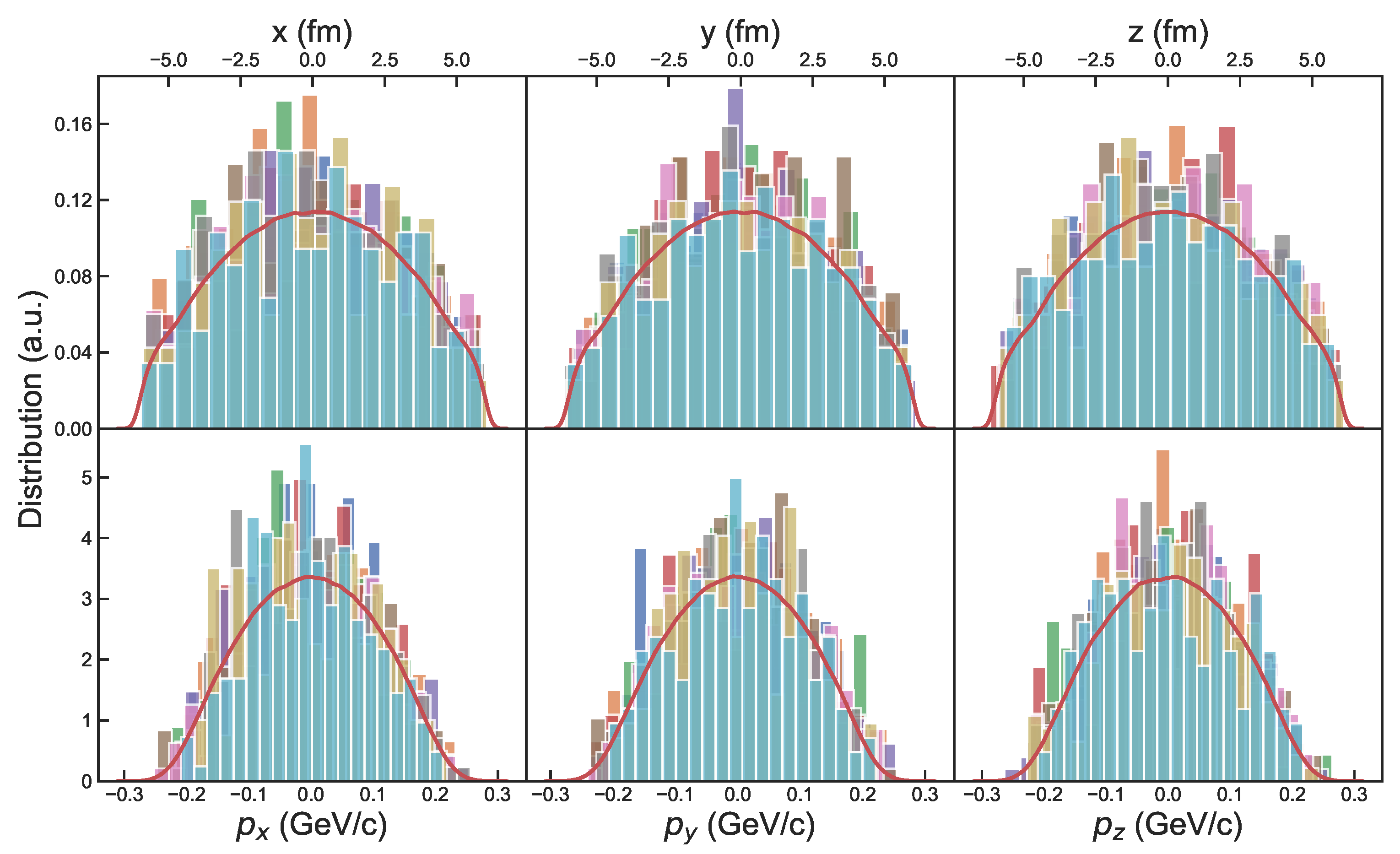
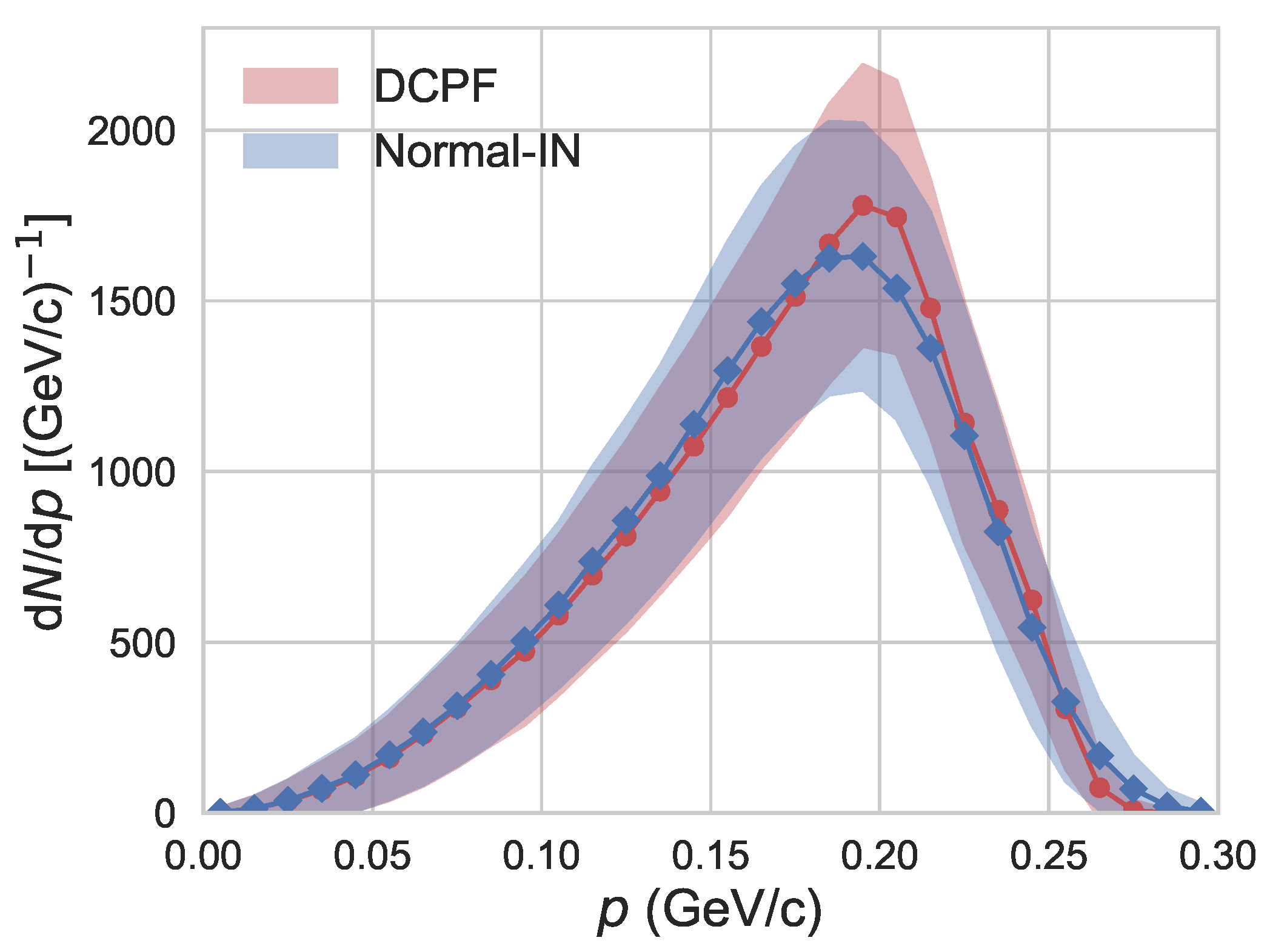
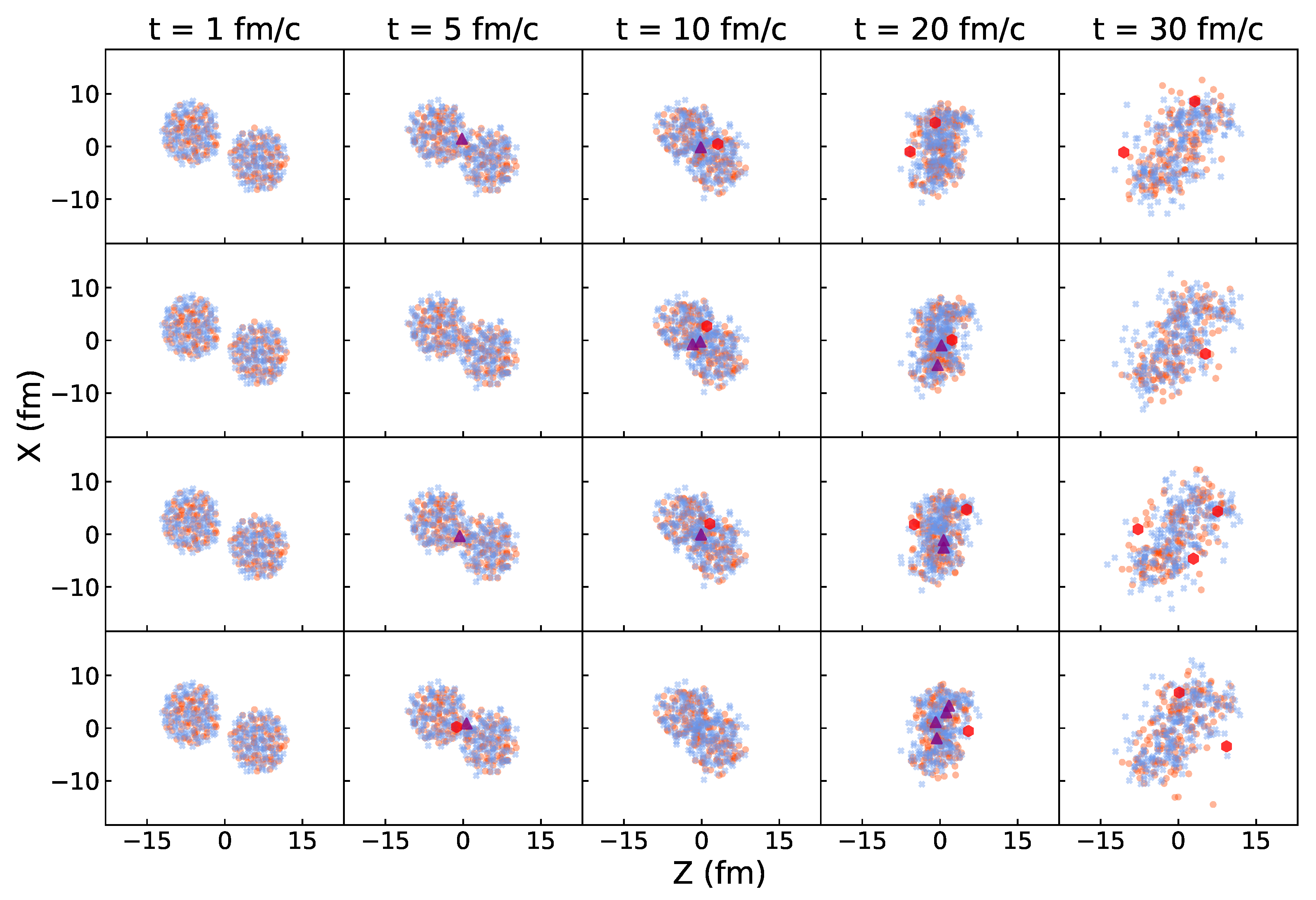
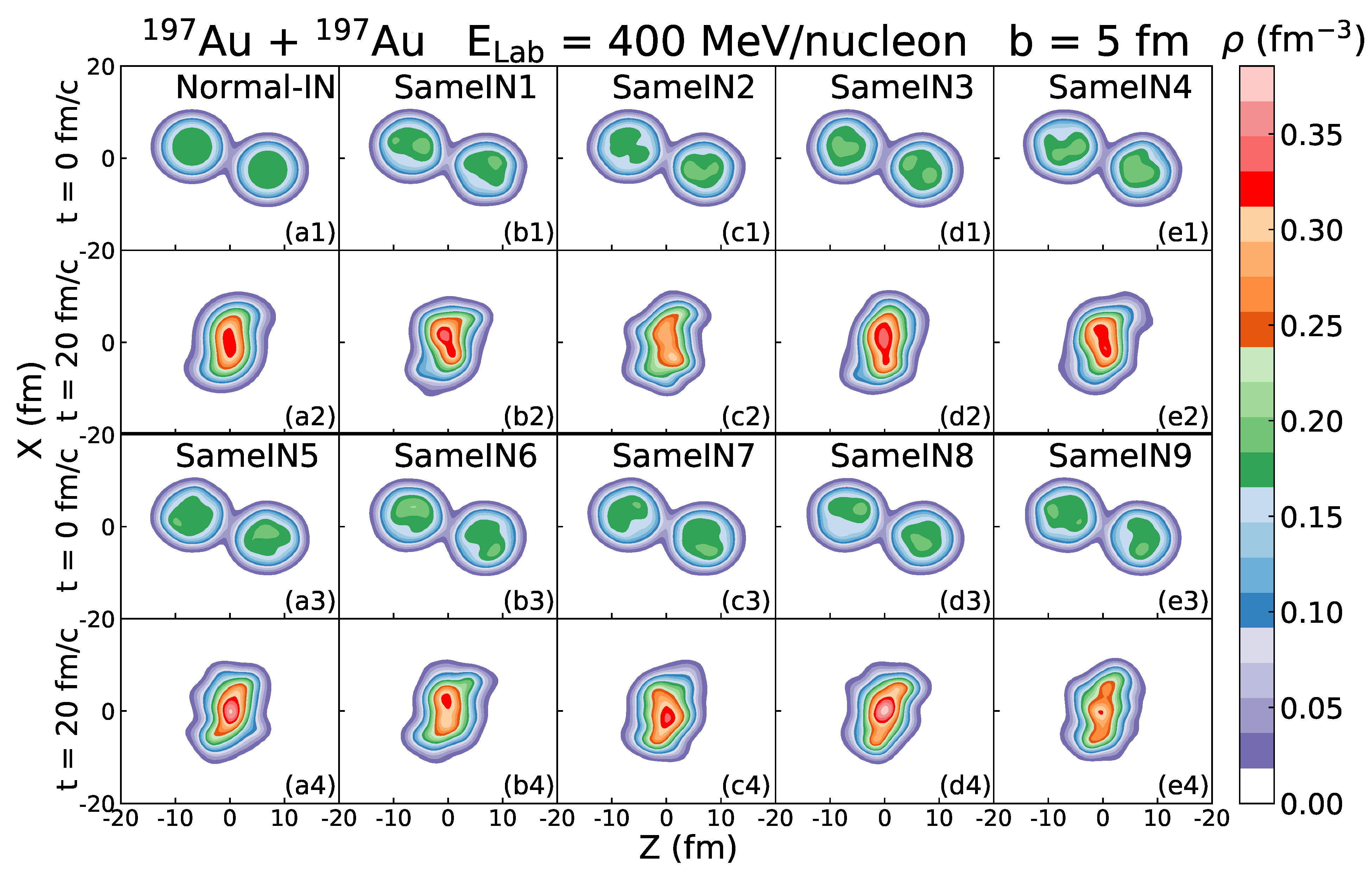
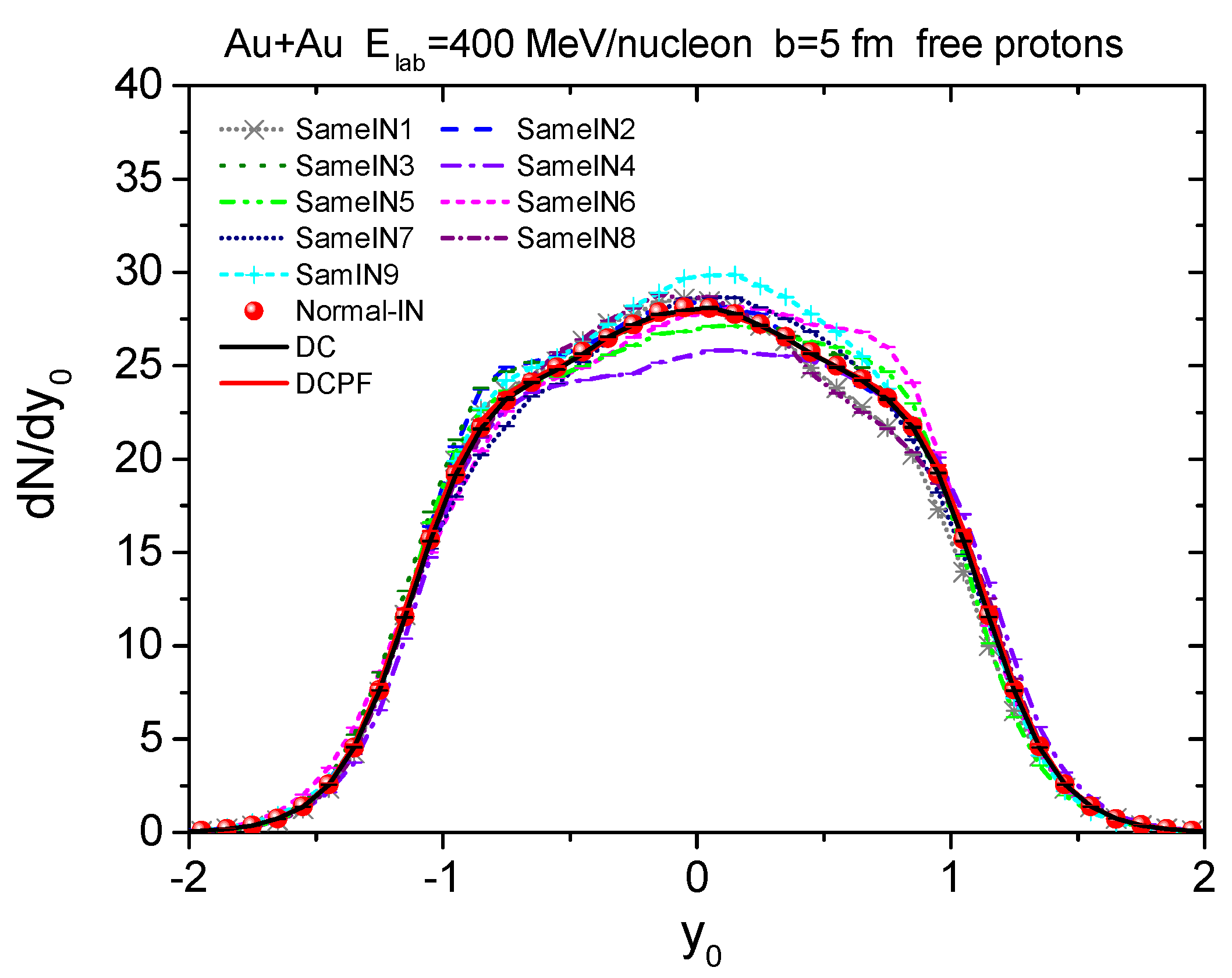
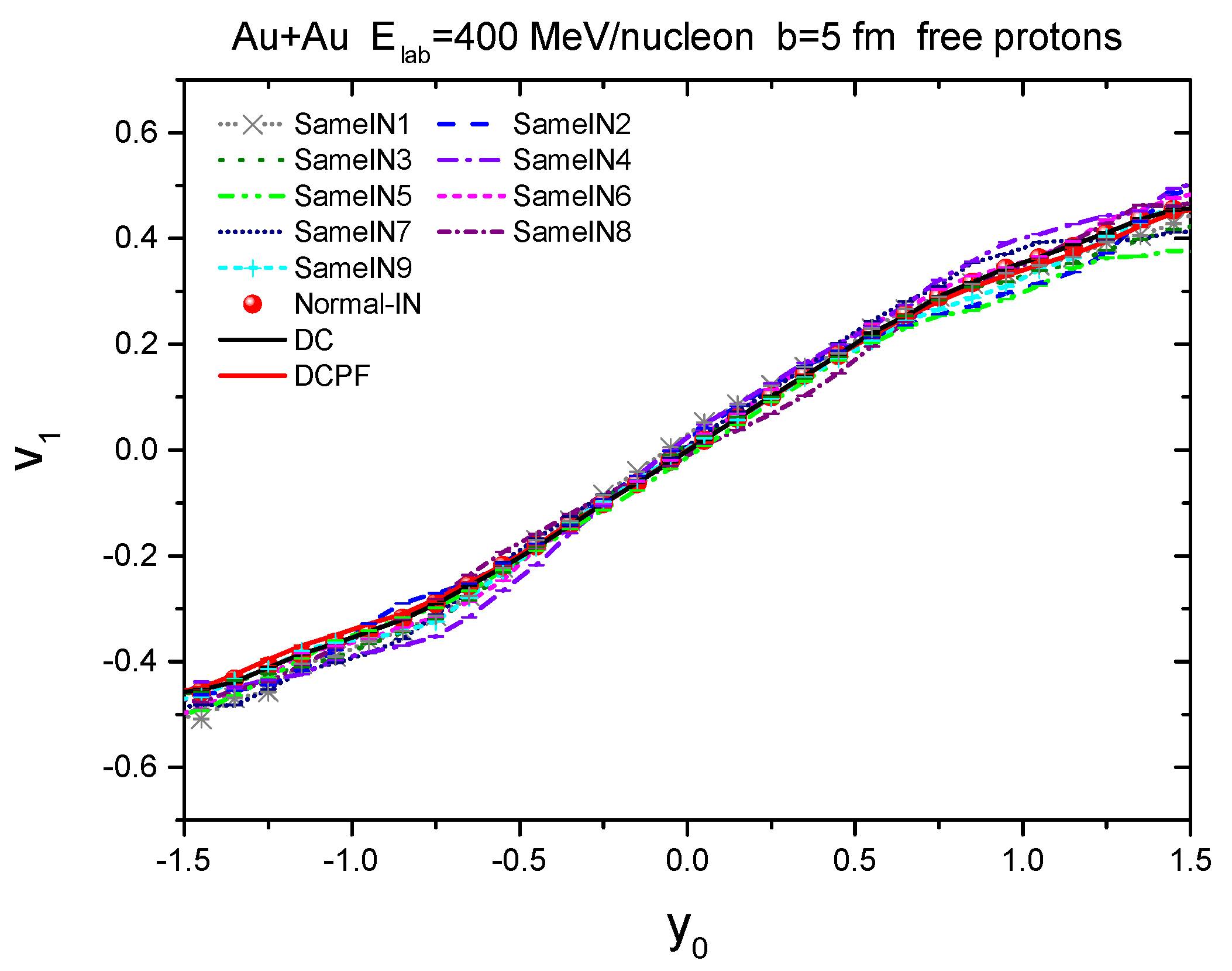
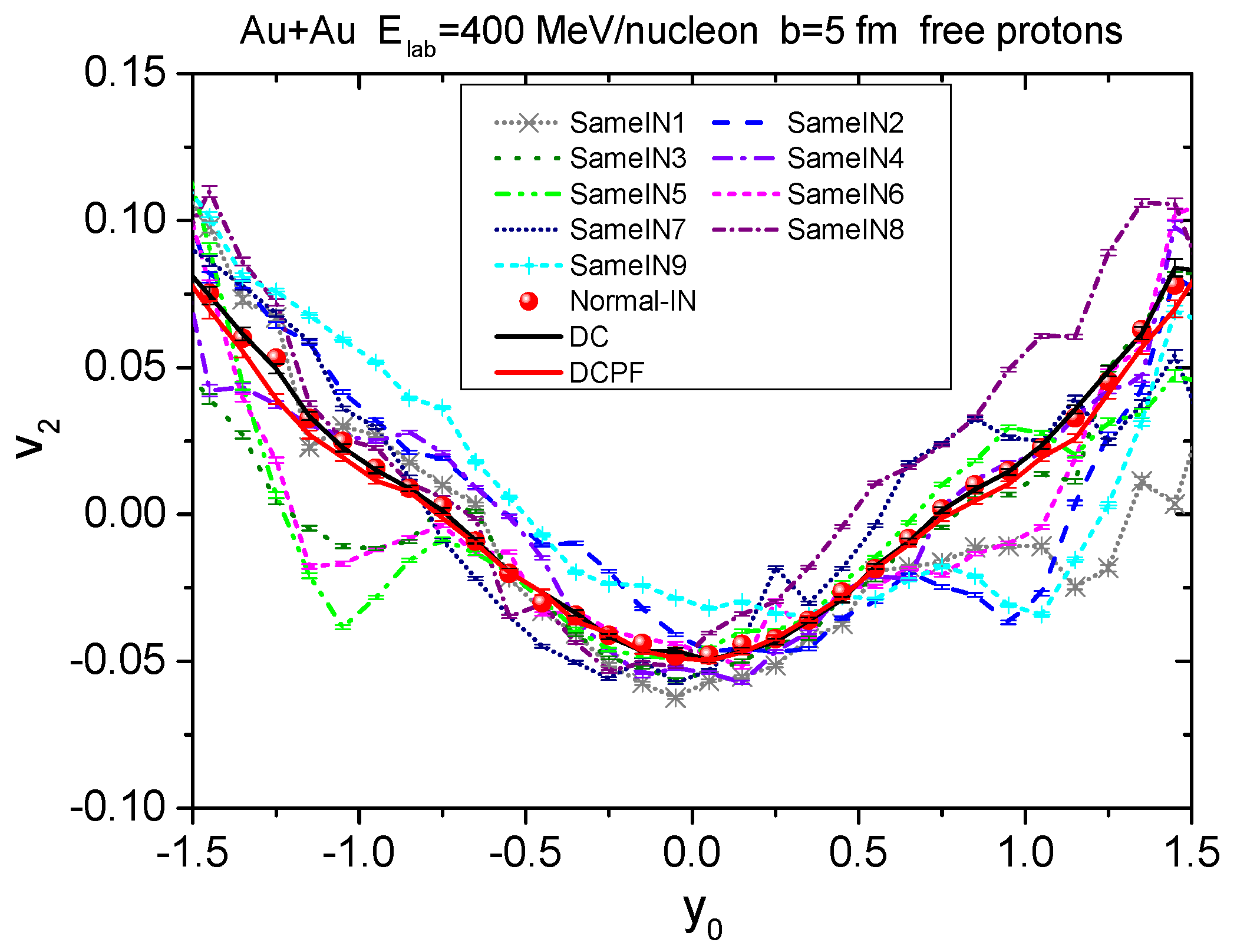
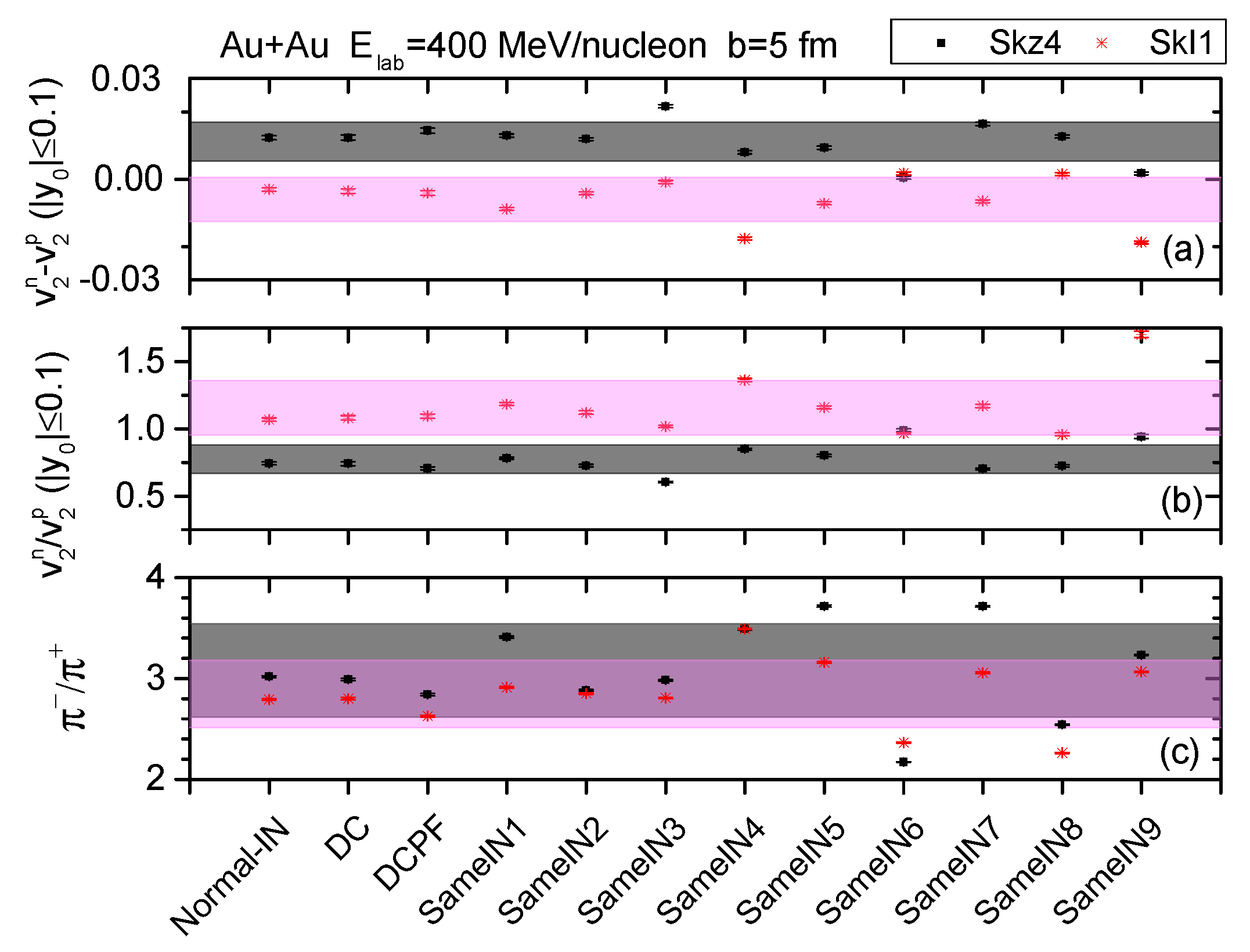
| Slope | () | / | / | / | / | / | / | H/He | H/He | |||||
|---|---|---|---|---|---|---|---|---|---|---|---|---|---|---|
| (soft) | (soft) | (soft) | (soft) | (soft) | (soft) | (soft) | (stiff) | (soft) | (stiff) | (soft) | (stiff) | (soft) | (stiff) | |
| Normal-IN | 114.8 | 58.7 | 1.223 | 0.405 | 0.41 | −0.040 | 1.96 | 1.36 | 0.67 | 1.12 | 3.02 | 2.79 | 2.69 | 1.65 |
| DC | 114.7 | 58.6 | 1.215 | 0.406 | 0.41 | −0.040 | 1.96 | 1.36 | 0.70 | 1.09 | 2.99 | 2.8 | 2.69 | 1.64 |
| DCPF | 115.4 | 59.1 | 1.216 | 0.428 | 0.41 | −0.041 | 1.95 | 1.34 | 0.65 | 1.10 | 2.84 | 2.63 | 2.70 | 1.65 |
| SameIN1 | 113.4 | 57.9 | 1.144 | 0.336 | 0.41 | −0.049 | 1.96 | 1.34 | 0.71 | 1.20 | 3.41 | 2.91 | 2.72 | 1.60 |
| SameIN2 | 114.9 | 59.8 | 1.202 | 0.417 | 0.45 | −0.034 | 1.92 | 1.37 | 0.63 | 1.30 | 2.88 | 2.85 | 2.69 | 1.61 |
| SameIN3 | 117.8 | 60.1 | 1.217 | 0.408 | 0.38 | −0.045 | 1.96 | 1.37 | 0.52 | 0.98 | 2.98 | 2.81 | 2.66 | 1.61 |
| SameIN4 | 115.0 | 56.8 | 1.121 | 0.321 | 0.47 | −0.043 | 2.02 | 1.42 | 0.77 | 1.49 | 3.49 | 3.49 | 2.61 | 1.65 |
| SameIN5 | 114.9 | 58.3 | 1.259 | 0.339 | 0.41 | −0.040 | 1.97 | 1.37 | 0.67 | 1.20 | 3.72 | 3.16 | 2.60 | 1.71 |
| SameIN6 | 116.9 | 59.7 | 1.148 | 0.529 | 0.43 | −0.039 | 1.96 | 1.38 | 1.00 | 1.02 | 2.17 | 2.37 | 2.67 | 1.70 |
| SameIN7 | 115.2 | 58.4 | 1.373 | 0.369 | 0.40 | −0.042 | 1.97 | 1.37 | 0.67 | 0.99 | 3.72 | 3.06 | 2.67 | 1.65 |
| SameIN8 | 113.1 | 58.5 | 0.994 | 0.391 | 0.30 | −0.037 | 1.94 | 1.31 | 0.64 | 1.01 | 2.54 | 2.26 | 2.81 | 1.69 |
| SameIN9 | 118.7 | 60.9 | 1.287 | 0.398 | 0.39 | −0.027 | 1.95 | 1.38 | 0.75 | 1.84 | 3.23 | 3.07 | 2.61 | 1.69 |
Publisher’s Note: MDPI stays neutral with regard to jurisdictional claims in published maps and institutional affiliations. |
© 2021 by the authors. Licensee MDPI, Basel, Switzerland. This article is an open access article distributed under the terms and conditions of the Creative Commons Attribution (CC BY) license (https://creativecommons.org/licenses/by/4.0/).
Share and Cite
Wang, Y.; Gao, Z.; Li, Q. Quantifying the Effect of Initial Fluctuations on Isospin-Sensitive Observables from Heavy-Ion Collisions at Intermediate Energies. Symmetry 2021, 13, 2172. https://doi.org/10.3390/sym13112172
Wang Y, Gao Z, Li Q. Quantifying the Effect of Initial Fluctuations on Isospin-Sensitive Observables from Heavy-Ion Collisions at Intermediate Energies. Symmetry. 2021; 13(11):2172. https://doi.org/10.3390/sym13112172
Chicago/Turabian StyleWang, Yongjia, Zepeng Gao, and Qingfeng Li. 2021. "Quantifying the Effect of Initial Fluctuations on Isospin-Sensitive Observables from Heavy-Ion Collisions at Intermediate Energies" Symmetry 13, no. 11: 2172. https://doi.org/10.3390/sym13112172
APA StyleWang, Y., Gao, Z., & Li, Q. (2021). Quantifying the Effect of Initial Fluctuations on Isospin-Sensitive Observables from Heavy-Ion Collisions at Intermediate Energies. Symmetry, 13(11), 2172. https://doi.org/10.3390/sym13112172






